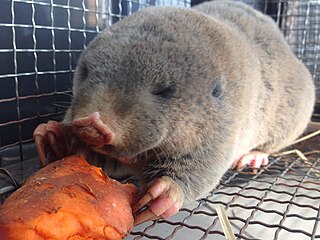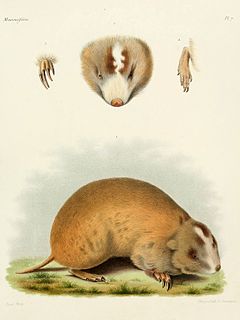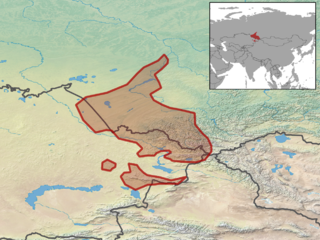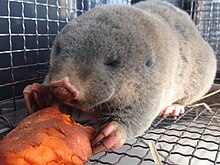Mole-rat or mole rat refers to several groups of burrowing Old World rodents:

The Muroidea are a large superfamily of rodents, including mice, rats, voles, hamsters, lemmings, gerbils, and many other relatives. Although the Muroidea originated in Eurasia, they occupy a vast variety of habitats on every continent except Antarctica. Some authorities have placed all members of this group into a single family, Muridae, due to difficulties in determining how the subfamilies are related to one another. Many of the families within the Muroidea superfamily have more variations between the families than between the different clades. A possible explanation for the variations in rodents is because of the location of these rodents; these changes could have been due to radiation or the overall environment they migrated to or originated in. The following taxonomy is based on recent well-supported molecular phylogenies.

Zokors are Asiatic burrowing rodents resembling mole-rats. They include two genera: Myospalax and Eospalax. Zokors are native to much of China, Kazakhstan, and Siberian Russia.

The Cricetidae are a family of rodents in the large and complex superfamily Muroidea. It includes true hamsters, voles, lemmings, muskrats, and New World rats and mice. At almost 608 species, it is the second-largest family of mammals, and has members throughout the Americas, Europe and Asia.

The Spalacidae, or spalacids, are a family of rodents in the large and complex superfamily Muroidea. They are native to eastern Asia, the Horn of Africa, the Middle East, and southeastern Europe. It includes the blind mole-rats, bamboo rats, mole-rats, and zokors. This family represents the oldest split in the muroid superfamily, and comprises animals adapted to a subterranean way of life. These rodents were thought to have evolved adaptations to living underground independently until recent genetic studies demonstrated they form a monophyletic group. Members of the Spalacidae are often placed in the family Muridae along with all other members of the Muroidea.

The rodent family Platacanthomyidae, or Oriental dormice, includes the spiny dormice and the Chinese pygmy dormice. In spite of their appearance, these animals are not true dormice, but are part of the large and complex superfamily Muroidea. The platacanthomyids can be distinguished from the true dormice, because they have no premolars, giving them three cheek teeth, like their relatives, the Muroidea.

Myospalax is a genus of rodents in the family Spalacidae. It contains these species of zokor:

Spalax is a genus of rodent in the family Spalacidae. It is one of two extant genera in the subfamily Spalacinae, alongside Nannospalax.

The blind mole-rats, also known as the fossorial or subterranean mole rats, are a subfamily (Spalacinae) of rodents in the family Spalacidae, found in eastern Europe and western & central Asia. The hystricognath mole-rats of the family Bathyergidae are completely unrelated, but some other forms are also in the family Spalacidae. Zokors, root rats, and bamboo rats are spalacids also sometimes referred to as mole rats.

The Siberian weasel or kolonok is a medium-sized weasel native to Asia, where it is widely distributed and inhabits various forest habitats and open areas. It is therefore listed as Least Concern on the IUCN Red List.

The upland buzzard is a species of bird of prey in the family Accipitridae. The largest species of the Buteo genus, this buzzard lives in mountainous grassy and rocky areas in areas of Central Asia, northern South Asia and East Asia from Kazakhstan to Korea. The upland buzzard is migratory but typically covers a short distance apparently to avoid snow cover that may hamper prey capture. This species primarily subsists on small mammals but does not shun alternate prey from small to large birds and insects. This little known raptor has a large range, and though generally uncommon, it is not thought to be rare or declining as a species. As a result it is classified as least concern by the IUCN.
The false zokor is a species of rodent in the family Spalacidae. It is found in Mongolia, China and Russia.

The Chinese zokor is a species of rodent in the family Spalacidae. It is endemic to China, ranging from Qinghai Province eastwards to Beijing in steppe and alpine grasslands. Henri Milne-Edwards first described it in 1867. Eradication programs in the 1990s in Qinghai Province resulted in a population decline to less than a third of the former population. It is considered common and has been assessed as Least Concern by IUCN.

The Siberian zokor is a species of rodent in the family Spalacidae. It is found in Kazakhstan and Russia.

The Transbaikal zokor is a species of rodent in the family Spalacidae. It is found in China, Mongolia, and Russia.
The Rothschild's zokor is a species of rodent in the family Spalacidae. It is endemic to China.
Smith's zokor is a species of rodent in the family Spalacidae, endemic to China.

Rodents are mammals of the order Rodentia, which are characterized by a single pair of continuously growing incisors in each of the upper and lower jaws. About 40% of all mammal species are rodents. They are native to all major land masses except for New Zealand, Antarctica, and several oceanic islands, though they have subsequently been introduced to most of these land masses by human activity.
Mammalian vision is the process of mammals perceiving light, analyzing it and forming subjective sensations, on the basis of which the animal's idea of the spatial structure of the external world is formed. Responsible for this process in mammals is the visual sensory system, the foundations of which were formed at an early stage in the evolution of chordates. Its peripheral part is formed by the eyes, the intermediate - the optic nerves, and the central - the visual centers in the cerebral cortex.














